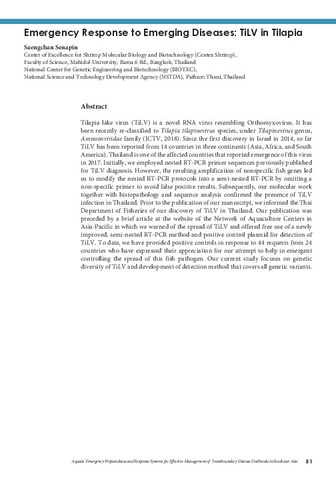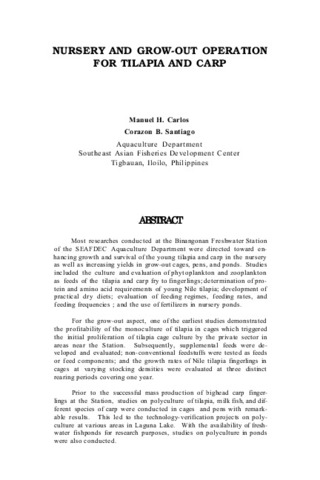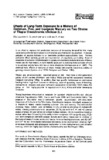Fatty acid composition of Nile tilapia Orechromis niloticus muscles: A comparative study with commercially important tropical freshwater fish in Philippines
Share
| dc.contributor.author | Suloma, Ashraf | |
| dc.contributor.author | Ogata, Hiroshi Y. | |
| dc.contributor.author | Garibay, Esteban S. | |
| dc.contributor.author | Chavez, Denny R. | |
| dc.contributor.author | El-Haroun, Ehab | |
| dc.contributor.editor | Elghobashy, H. | |
| dc.contributor.editor | Fitzsimmons, Kevin | |
| dc.contributor.editor | Diab, A. S. | |
| dc.coverage.spatial | Binangonan | en |
| dc.coverage.spatial | Rizal | en |
| dc.coverage.spatial | Philippines | en |
| dc.date.accessioned | 2023-08-10T08:22:30Z | |
| dc.date.available | 2023-08-10T08:22:30Z | |
| dc.date.issued | 2008 | |
| dc.identifier.uri | http://hdl.handle.net/10862/6463 | |
| dc.description.abstract | Six tropical freshwater species were collected from Philippines in order to study the characteristic of polyunsaturated fatty acids distributions. 16:0 and 18: l n-9 were the predominant saturated fatty acid (SFA) and monounsaturated fatty acid (MUFA) in both neutral lipids (NL) and polar lipids (PL). There was an absence or very low values of n3 highly unsaturated fatty acid (HUFA) in NL of all species. However these fatty acids found in PL of all species studied with higher levels. The high proportions of docosahexaenoic acid (DHA) in PL were found with catfish Arius (20.71%), ayungin (17.64%), and snakehead (17.09%) whereas anabas (4.21%) gave lower DHA content. In PL, arachidonic acids (ARA) was found in high proportions, and also is superior to eicosapentaenoic acid (EPA) (ranged from 3.35 to 10.67% and from 0.42 to 4.74%, respectively). Tilapia lipid appears to be intermediate in nutritional quality between all species studied; the proportions of DHA, EPA and ARA in PL were 16.27%, 4.52% and 9.36%, respectively. According to the n-3/n-6 ratio in both fractions, only ayungin is in the range typical of freshwater fish. Our results indicate that the wild tropical freshwater fish studied here are not good sources of n-3 HUFA fatty acids. Therefore, aquatic nutritionists and farmers should combine their efforts in order to manipulate the nutritional quality of these species to enhance their n-3 HUFAs concentrations especially when these species are reared in captivity system. The wash-out strategy may provide an adequate description of the changes in the fillet lipid fatty acid profiles of fatty fish. | en |
| dc.language.iso | en | en |
| dc.publisher | AquaFish Collaborative Research Support Program | en |
| dc.relation.uri | https://ag.arizona.edu/azaqua/ista/ISTA8/FinalPapers/11%20Nutrition/PDF/17%20El-Haroun.pdf | en |
| dc.subject | Oreochromis niloticus | en |
| dc.subject | Channa striatus | en |
| dc.subject | Anabas testudineus | en |
| dc.subject | Clarias gariepinus | en |
| dc.subject | Arius | en |
| dc.subject | tilapia | en |
| dc.subject | docosahexaenoic acid | en |
| dc.subject | eicosapentaenoic acid | en |
| dc.title | Fatty acid composition of Nile tilapia Orechromis niloticus muscles: A comparative study with commercially important tropical freshwater fish in Philippines | en |
| dc.type | Conference paper | en |
| dc.citation.spage | 921 | en |
| dc.citation.epage | 932 | en |
| dc.subject.asfa | tilapia culture | en |
| dc.subject.asfa | fatty acids | en |
| dc.subject.asfa | freshwater fishes | en |
| dc.subject.asfa | lipids | en |
| dc.citation.conferenceTitle | Proceedings of 8th International Symposium on Tilapia in Aquaculture, Cairo, Egypt, 12-14 Oct 2008 | en |
| dc.subject.scientificName | Oreochromis niloticus | en |
| dc.subject.scientificName | Channa striatus | en |
| dc.subject.scientificName | Anabas testudineus | en |
| dc.subject.scientificName | Leiopotherapon plumbeus | en |
| dc.subject.scientificName | Clarias gariepinus | en |
| dc.subject.scientificName | Arius argyropleuron | en |
| local.subject | Tropical freshwater fish | en |
| local.subject | Polar lipids | en |
| local.subject | Neutral lipids | en |
| local.subject | docosahexaenoic acid | en |
| local.subject | eicosapentaeoic acid | en |
| local.subject | Arachidonic acid | en |
Files in this item
| Files | Size | Format | View |
|---|
This item appears in the following Collection(s)
-
AQD Conference Proceedings [300]
These papers were contributed by AQD staff to various national and international Conferences



